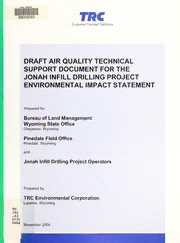Table Of ContentBLM LIBRARY
TftC
88058365
Customer-Focused Solutions
DRAFT AIR QUALITY TECHNICAL
SUPPORT DOCUMENT FOR THE
JONAH INFILL DRILLING PROJECT
ENVIRONMENTAL IMPACT STATEMENT
Prepared for
Bureau of Land Management
Wyoming
State Office
Cheyenne, Wyoming
Pinedale Field Office
Pinedale, Wyoming
and
Jonah Infill Drilling Project Operators
Prepared by
TRC Environmental Corporation
Laramie, Wyoming
TD
195
.G3
D735
2004
November 2004
i
€
LG ib: 8S05i3C0 ,2
63
•
DRAFT
AIR QUALITY TECHNICAL SUPPORT DOCUMENT FOR
THE JONAH INFILL DRILLING PROJECT
ENVIRONMENTAL IMPACT STATEMENTS
V^>\
Prepared for
^
Bureau of Land Management 4x. ^V
Wyoming State Office ° 9 <^
&0 '
Cheyenne, Wyoming *& ™fy
and
Pinedale Field Office
Pinedale, Wyoming
and
Jonah Infill Drilling Project Operators
By
TRC
Environmental Corporation
Laramie, Wyoming
MAI Project 35982
November 2004
Air Quality Technical Support Document, Jonah Infill DrillingProject
EXECUTIVE SUMMARY
To be completed upon receipt ofagency comments.
35982 TRCEnvironmental Corporation
Air Quality TechnicalSupportDocument, Jonah Infill DrillingProject
TRCEnvironmental Corporation
35982
11
Air Quality TechnicalSupportDocument, Jonah Infill Drilling Project iii
TABLE OF CONTENTS
Page
LIST OF ACRONYMS AND ABBREVIATIONS vii
INTRODUCTION
1.0
1
1.1 PROJECT DESCRIPTION 4
ALTERNATIVES EVALUATED
1.2 5
STUDY TASKS
1.3 7
2.0 EMISSIONS INVENTORY 9
2.1 PROJECT EMISSIONS 9
2.1.1 Construction Emissions 9
2.1.2 Production Emissions 1
2.1.3 Total Field Emissions 14
2.2 REGIONAL EMISSIONS INVENTORY 14
3.0 NEAR-FIELD MODELING ANALYSES 25
MODELING METHODOLOGY
3.1 25
METEOROLOGY DATA
3.2 25
3.3 BACKGROUND POLLUTANT CONCENTRATIONS 27
3.4 CRITERIA POLLUTANT IMPACT ASSESSMENT 28
3.4.1 PM10/PM2.5 29
3.4.2 S0 32
2
N0
3.4.3 32
2
CO
3.4.4 37
3.4.4 38
3
3.5 HAP IMPACT ASSESSMENT 40
4.0 MID-FIELD AND FAR-FIELD ANALYSES 47
4.1 MODELING METHODOLOGY 48
4.2 PROJECT ALTERNATIVE MODELING SCENARIOS 49
METEOROLOGICAL MODEL INPUT AND OPTIONS
4.3 5
4.4 DISPERSION MODEL INPUT AND OPTIONS 55
4.4.1 Chemical Species 55
4.4.2 Model Receptors 56
4.4.3 Source Parameters 56
BACKGROUND DATA
4.5 61
4.5.1 Criteria Pollutants 61
4.5.2 Visibility 61
4.5.3 Lake Chemistry 65
4.6 IMPACT ASSESSMENT 65
4.6.1 Concentration 66
4.6.2 Deposition 70
35982 TRCEnvironmental Corporation
1
IV Air Quality Technical SupportDocument, Jonah InfillDrilling Project
TABLE OF CONTENTS (CONTINUED)
Page
4.6.3 Sensitive Lakes 71
%
4.6.4 Visibility 71
REFERENCES
5.0 79
APPENDIX A: AIR QUALITY ASSESSMENT PROTOCOL
APPENDIX B: PROJECT EMISSIONS INVENTORIES
APPENDIX C: CUMULATIVE EMISSIONS INVENTORIES %
APPENDIX D: REGIONAL COMPRESSION EXISTING AND PROPOSED
APPENDIX CALMET INPUT DATA
E:
APPENDIX MAXIMUM PREDICTED MID-FIELD AND FAR-FIELD IMPACTS
F:
LIST OF MAPS
Page
Map 1 . Jonah Infill Drilling Project Location, Sublette County, Wyoming 2
Map 1.2 Air Quality Study Area/Modeling Domain 3
%
Map 2.1 Regional Inventory Area and Included NEPA Project Areas 23
%
•
•
•
LIST OF TABLES
•
•
Page
•
Table 2. Single-well Construction Emissions Summary for Both Straight and •
Directionally Drilled Wells 12
•
Table 2.2 Single-Well Production Emissions Summary 13
35982 TRCEnvironmental Corporation
1 5
Air Quality TechnicalSupport Document, Jonah Infill Drilling Project
LIST OF TABLES (CONTINUED)
Page
Table 2.3 Estimated Jonah Infill Drilling Project Maximum Annual In-field
Emissions Summary - Construction and Production 1
Table 2.4 Regional Inventory Summary ofEmissions Changes from
January 1, 2001, to June 30, 2003 24
Table 3.1 Near-Field Analysis Background Ambient Air Quality Concentrations
(Micrograms per Cubic Meter [ug/nr 27
])
Table 3.2 Ambient Air Quality Standards and Class II PSD Increments for
Comparison to Near-Field Analysis Results (ug/m 28
)
Table 3.3 Maximum Modeled PM10/PM2.5 Concentrations, Jonah Infill Drilling
Project 31
Table 3.4 Maximum Modeled SO2 Concentrations, Jonah Infill Drilling Project 34
Table 3.5 Maximum Modeled Annual NO2 Concentrations, Jonah Infill Drilling
Project 37
Table 3.6 Maximum Modeled CO Concentrations, Jonah Infill Drilling Project 38
Table 3.7 Maximum Modeled O3 Concentrations, Jonah Infill Drilling Project 40
Table 3.8 Maximum Modeled 1-Hour HAP Concentrations, Jonah Infill Drilling
Project 43
Table 3.9 Maximum Modeled Long-term (Annual) HAP Concentrations, Jonah Infill
Drilling Project 44
Table 3.10 Long-term Modeled MLE and MEI Cancer Risk Analyses, Jonah Infill
Drilling Project 46
Table 4. Summary ofModeled Project Alternatives, Jonah Infill Drilling Project,
Sublette County, Wyoming, 2004 50
Table 4.2 Summary ofMaximum Modeled Field-Wide Emissions (tpy), Jonah Infill
Drilling Project, Sublette County, Wyoming, 2004 52
Table 4.3 Far-field Analysis Background ofAmbient Air Quality Concentrations
(pg/m3 64
)
Table 4.4 IMPROVE Background Aerosol Extinction Values 64
35982 TRCEnvironmental Corporation
1
%
VI Air Quality TechnicalSupport Document, Jonah InfillDrillingProject
%
•
LIST OF TABLES (CONTINUED)
•
Page
•
ANC %
Table 4.5 Background Values for Acid Sensitive Lakes 65
Table 4.6 Modeling Scenarios Analyzed for Project Alternative and Regional
Emissions, Jonah Infill Drilling Project, Sublette County, Wyoming, 2004 67
Table 4.7 NAAQS, WAAQS, PSD Class I and Class II Increments, and PSD Class I
and Class II Significance Levels for Comparison to Far-field Analysis
Results (pg/m3 68
)
Table 4.8 FLAG Report Background Extinction Values 73
Table 4.9 Monthly f(RH) Factors Factors from Regional Haze Rule Guidance 74
LIST OF FIGURES
Page
Figure 2.1 Approximate Single-Well Development Timeline 10
Figure 3.1 Wind Rose, Jonah Field, 1999 26
Figure 3.2 Near-field Modeling PM10/PM2.5 Source and Receptor Layout 30 •
Figure 3.3 Near-field Modeling SO2 Source and Receptor Layout 33
Figure 3.4 Near-field Modeling NO CO, and HAPs Source and Receptor Layout 35
x,
Figure 3.5 Short-term HAPs Source and Receptor Layout 41 %
%
Figure 4. Mid-field Modeling Receptor Locations 57
•
Figure 4.2 Far-field Modeling Receptor Locations 58 •
•
Figure 4.3 Far-field Modeling Area Compressor Locations 59
Figure 4.4 Far-field Modeling Project-Specific Point and Area Source Locations 60
Figure 4.5 Far-field Modeling Idealization ofNEPA Project Areas 62
•
Figure 4.6 Far-field Modeling Idealization ofCounty Oil and Gas Well Area Sources 63
•
35982 TRCEnvironmental Corporation •

